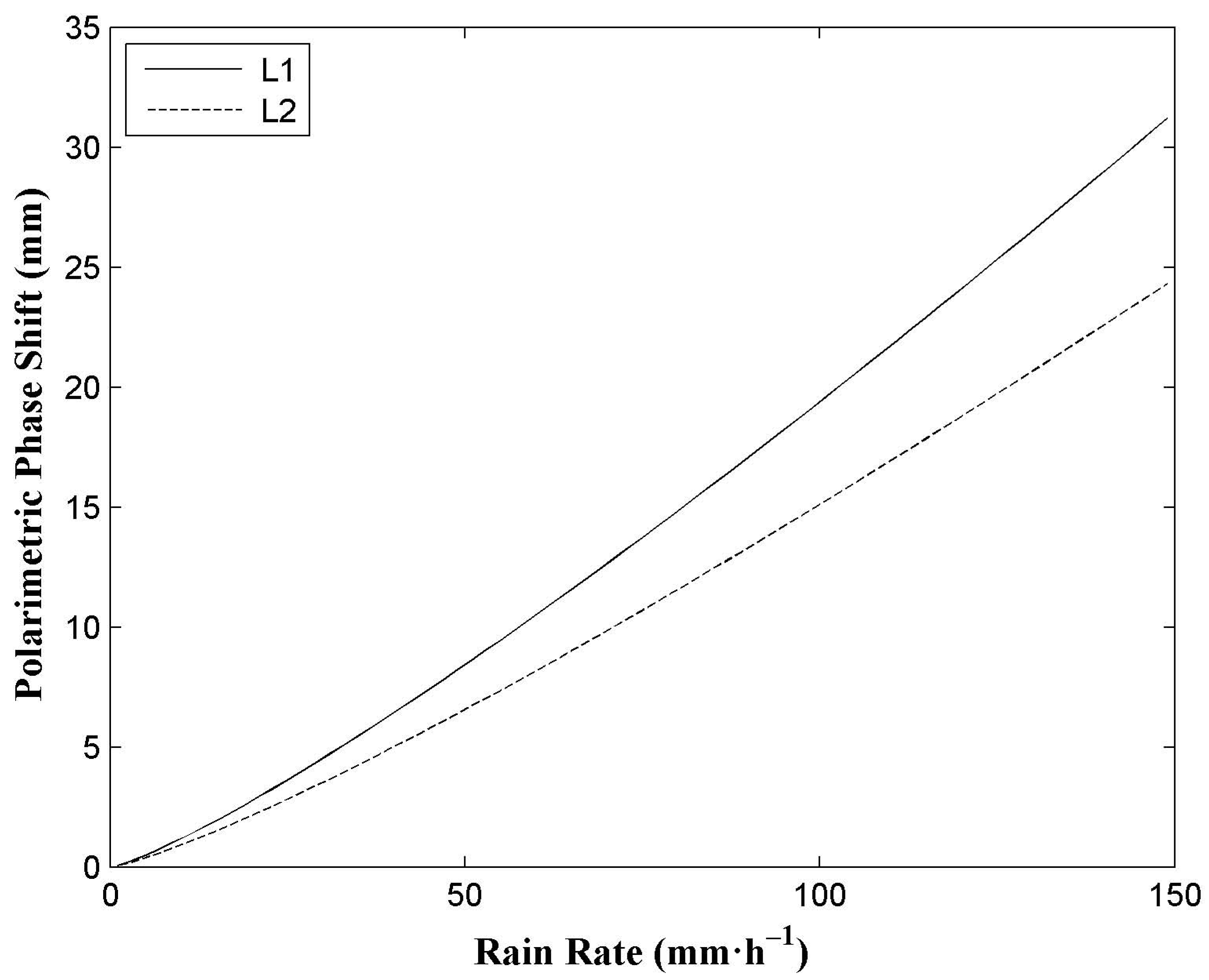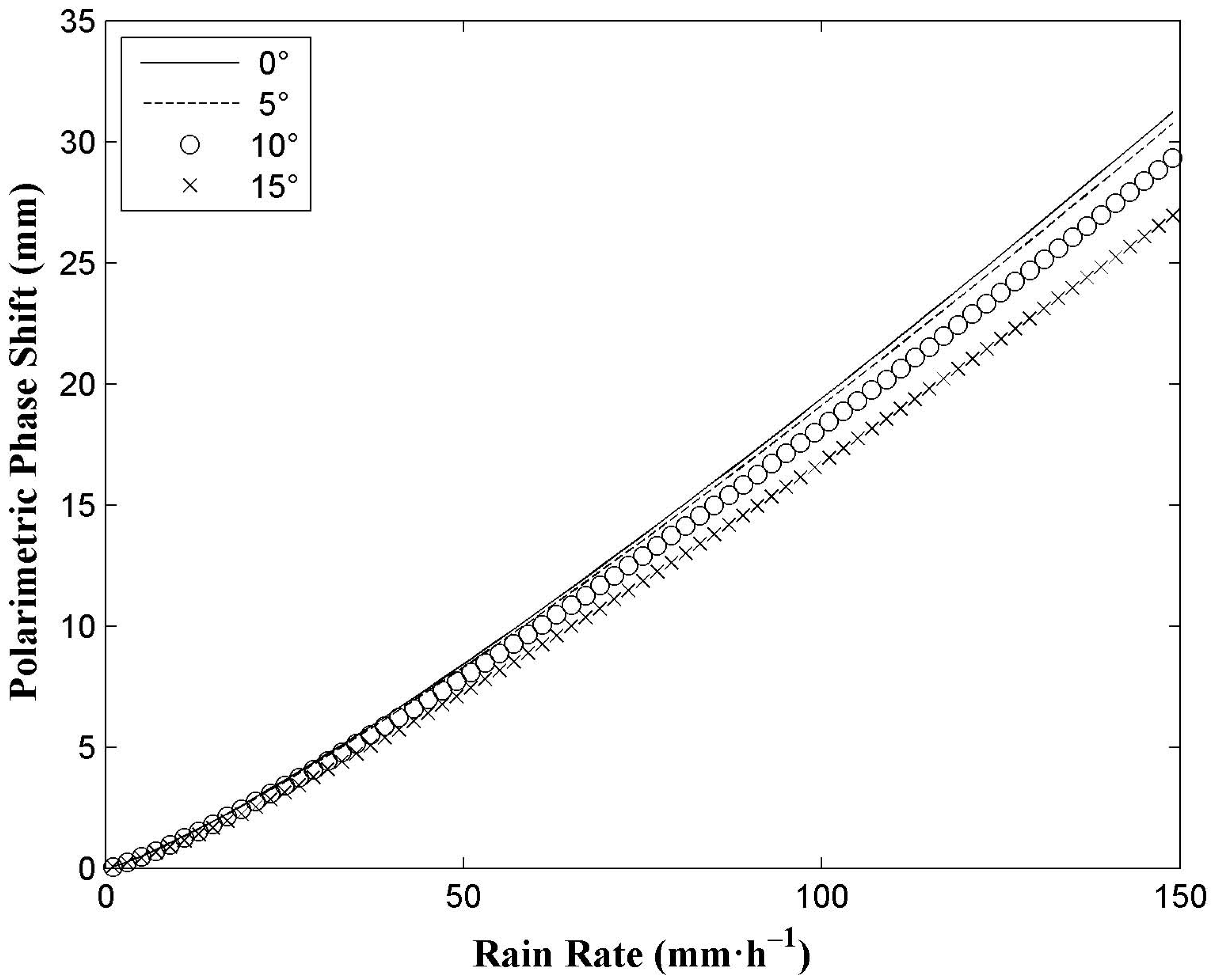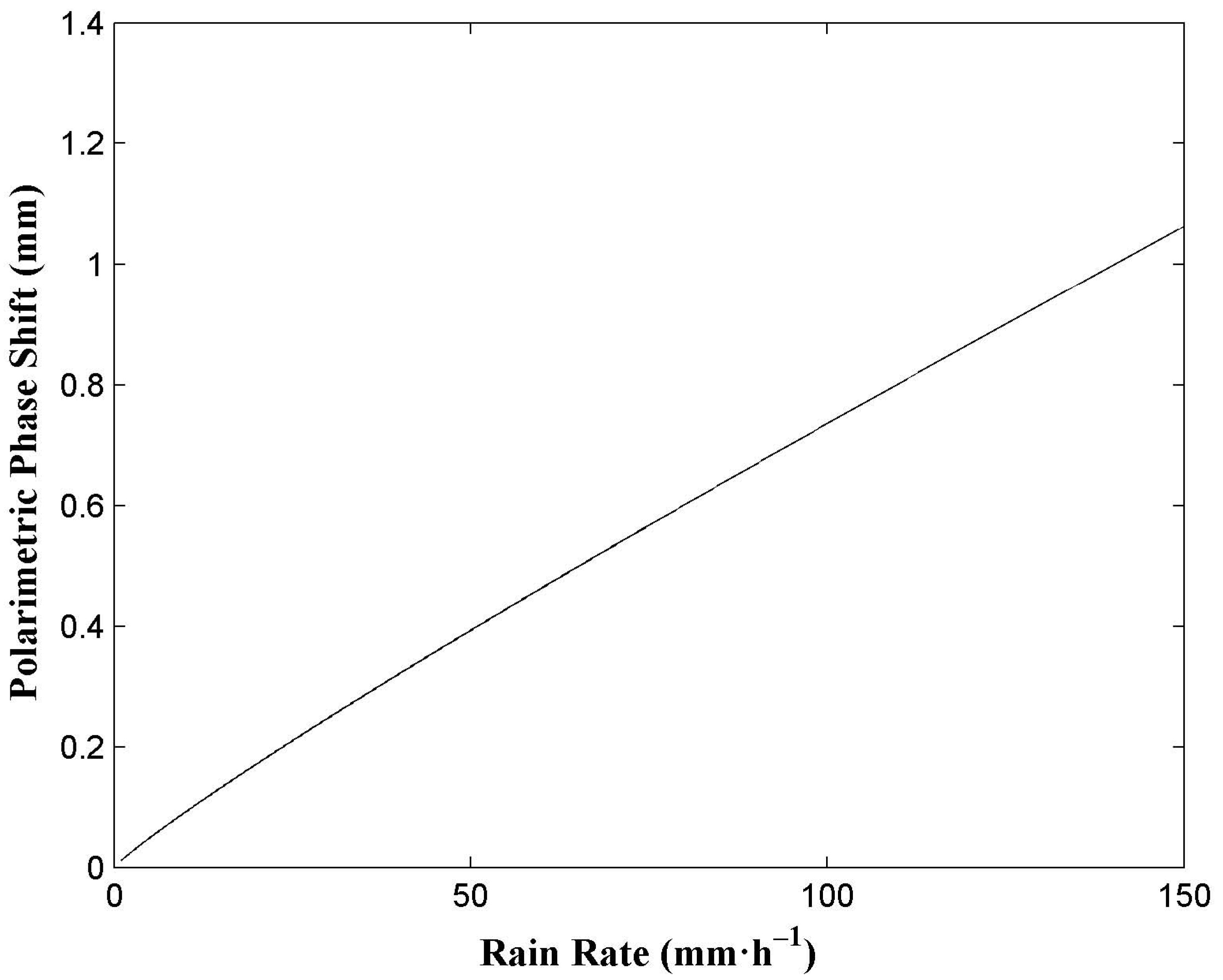GNSS Measurement of Rain Rate by Polarimetric Phase Shift: Theoretical Analysis
Abstract
:1. Introduction
2. Methods
2.1. Nonspherical Raindrop Shape Model
2.2. Raindrop Size Distribution
2.3. Calculation Model of Polarimetric Phase Shift
3. Results and Discussion
3.1. Variations of Polarimetric Phase Shift with Rain Rate
3.2. Effect of Raindrop Size Distribution
3.3. Effect of Rain Path Length
3.4. Effect of Raindrop Canting Angle
3.5. Effect of Temperature
3.6. Effects of Cloud Particles
3.6.1. Preliminary Assessment of the Effect of Ice Crystals
3.6.2. Preliminary Assessment of the Effect of Melting Particles
3.7. Effects of the Ionosphere
4. Conclusions
Acknowledgments
Author Contributions
Conflicts of Interest
References
- McCormick, G.C.; Hendry, A. Principles for the radar determination of the polarization properties of precipitation. Radio Sci. 1975, 10, 421–434. [Google Scholar] [CrossRef]
- Okamura, S.; Oguchi, T. Electromagnetic wave propagation in rain and polarization effects. Proc. Jpn. Acad. Ser. B Phys. Biol. Sci. 2010, 86, 539–562. [Google Scholar] [CrossRef] [PubMed]
- Goddard, J.W.; Cherry, S.M. The ability of dual-polarization radar (copolar linear) to predict rainfall rate and microwave attenuation. Radio Sci. 1984, 19, 201–208. [Google Scholar] [CrossRef]
- Jameson, A.R. The meteorological parameterization of specific attenuation and polarization differential phase shift in rain. J. Appl. Meteorol. 1993, 32, 1741–1750. [Google Scholar] [CrossRef]
- Kalinga, O.A.; Gan, T.Y. Merging WSR-88D stage III radar rainfall data with rain gauge measurements using wavelet analysis. Int. J. Remote Sens. 2012, 33, 1078–1105. [Google Scholar] [CrossRef]
- Chandrasekar, V.; Bringi, V.N.; Balakrishnan, N.; Zrnic, D.S. Error structure of multiparameter radar and surface measurements of rainfall. Part III: Specific differential phase. J. Atoms. Ocean. Technol. 1990, 7, 621–629. [Google Scholar] [CrossRef]
- English, M.; Kochtubajda, B.; Barlow, F.D.; Holt, A.R.; McGuinness, R. Radar measurement of rainfall by differential propagation phase: A pilot experiment. Atmos.-Ocean 1991, 29, 357–380. [Google Scholar] [CrossRef]
- Notaroš, B.M.; Bringi, V.N.; Kleinkort, C.; Kennedy, P.; Huang, G.-J.; Thurai, M.; Newman, A.J.; Bang, W.; Lee, G. Accurate characterization of winter precipitation using multi-angle snowflake camera, visual hull, advanced scattering nethods and polarimetric radar. Atmosphere 2016, 7. [Google Scholar] [CrossRef]
- Thombre, S.; Hurskainen, H.; Nurmi, J. Wideband, high gain, high linearity, low noise amplifier for GNSS frequencies with compensation for low frequency instability. In Proceedings of the 2010 5th Advanced Satellite Multimedia Systems Conference and the 11th Signal Processing for Space Communications Workshop, Cagliari, Italy, 13–15 September 2010.
- Wang, H.; He, J.; Wei, M.; Zhang, Z. Synthesis analysis of one severe convection precipitation event in Jiangsu using ground-based GPS technology. Atmosphere 2015, 6, 908–927. [Google Scholar] [CrossRef]
- Jin, S.G.; Cardellach, E.; Xie, F.Q. GNSS Remote Sensing: Theory, Methods and Applications; Springer: Berlin, Germany, 2014. [Google Scholar]
- Cardellach, E.; Rius, A.; Cerezo, F. Polarimetric GNSS Radio-Occultations for heavy rain detection. In Proceedings of the Geoscience and Remote Sensing Symposium (IGARSS) 2010 IEEE International, Honolulu, HI, USA, 25–30 July 2010.
- Cardellach, E.; Tomás, S.; Oliveras, S.; Padullés, R.; Rius, A.; de la Torre-Juárez, M.; Turk, F.J.; Ao, C.O.; Kursinski, E.R.; Schreiner, B.; et al. Sensitivity of PAZ LEO polarimetric GNSS radio-occultation experiment to precipitation events. IEEE Trans. Geosci. Remote Sens. 2015, 53, 190–206. [Google Scholar] [CrossRef]
- Ajewole, M.O.; Kolawole, L.B.; Ajayi, G.O. Cross polarization on line-of-sight links in a tropical location: Effects of the variation in canting angle and rain dropsize distributions. IEEE Trans. Antennas Propag. 1999, 47, 1254–1259. [Google Scholar] [CrossRef]
- Beard, K.V.; Chuang, C. A new model for the equilibrium shape of raindrops. J. Atmos. Sci. 1987, 44, 1509–1524. [Google Scholar] [CrossRef]
- Bahrami, M.; Mohassel, J.R.; Taheri, M.M. An exact solution of coherent wave propagation in rain medium with realistic raindrop shapes. Progr. Electromagn. Res. 2008, 79, 107–118. [Google Scholar] [CrossRef]
- Beard, K.V.; Bringi, V.N.; Thurai, M. A new understanding of raindrop shape. Atmos. Res. 2010, 97, 396–415. [Google Scholar] [CrossRef]
- Pruppacher, H.R.; Klett, J.D. Microphysics of Clouds and Precipitation; Kluwer: Dordrecht, The Netherlands, 1997. [Google Scholar]
- Adirosi, E.; Baldini, L.; Lombardo, F.; Russo, F.; Napolitano, F.; Volpi, E.; Tokay, A. Comparison of different fittings of drop spectra for rainfall retrievals. Adv. Water Resour. 2015, 83, 55–67. [Google Scholar] [CrossRef]
- Marschall, J.S.; Palmer, W.K. The distribution of raindrops with size. J. Atmos. Sci. 1948, 5, 165–166. [Google Scholar] [CrossRef]
- Ulbrich, C.W. Natural variations in the analytical form of the raindrop-size distribution. J. Climate Appl. Meteor. 1983, 22, 1764–1775. [Google Scholar] [CrossRef]
- Mätzler, C. Drop-Size Distributions and Mie Computations for Rain; IAP Research Report No. 2002-16, Bern, Switzerland, November 2002.
- Ajayi, G.O.; Olsen, R.L. Modeling of a tropical raindrop size distribution for microwave and millimeter wave applications. Radio Sci. 1985, 20, 193–202. [Google Scholar] [CrossRef]
- Sekine, M.; Lind, G. Rain Attenuation of Centimeter, Millimeter and Submillimeter Radio Waves. In Proceedings of the 12th European Microwave Conference, Helsinki, Finland, 13–17 September 1982.
- Zhang, G.; Vivekanandan, J.; Brandes, E. A method for estimating rain rate and drop size distribution from polarimetric radar measurements. IEEE Trans. Geosci. Remote Sens. 2000, 39, 830–841. [Google Scholar] [CrossRef]
- Oguchi, T. Electromagnetic Wave Propagation and Scattering in Rain and Other Hydrometeors. Proc. IEEE 1983, 71, 1029–1079. [Google Scholar] [CrossRef]
- Duffo, N.; Vall llossera, M.; Camps, A.; Corbella, I.; Torres, F. Polarimetric emission of rain events: Simulation and experimental results at X-Band. Remote Sens. 2009, 1, 107–121. [Google Scholar] [CrossRef] [Green Version]
- Draine, B.T.; Flatau, P.J. Discrete-dipole approximation for scattering calculations. J. Opt. Soc. Am. A 1994, 11, 1491–1499. [Google Scholar] [CrossRef]
- Mishchenko, M.I.; Travis, L. Capabilities and limitations of a current FORTRAN implementation of the T-matrix method for randomly oriented, rotationally symmetric scatterers. J. Quant. Spectrosc. Radiat. Transfer 1998, 60, 309–324. [Google Scholar] [CrossRef]
- Al-Rizzo, H.M.; Tranquilla, J.M.; Al-Amri, S.M.; Alhafid, H.T. Application of the generalized multipole technique (GMT) to high-frequency electromagnetic scattering from perfectly conducting and dielectric bodies of revolution. J. Comput. Phys. 1997, 136, 1–18. [Google Scholar] [CrossRef]
- Ray, P.S. Broadband complex refractive indices of ice and water. Appl. Opt. 1972, 11, 1836–1844. [Google Scholar] [CrossRef] [PubMed]
- Bringi, V.N.; Chandrasekar, V.; Hubbert, J.; Gorgucci, E.; Randeu, W.L.; Schoenhuber, M. Raindrop size distribution in different climatic regimes from disdrometer and dual-polarized radar analysis. J. Atmos. Sci. 2003, 60, 354–365. [Google Scholar] [CrossRef]
- Al-Rizzo, H.M.; Al-Hafid, H.T.; Tranquilla, J.M. Electromagnetic modeling of the propagation characteristics of satellite communications through composite precipitation layers, Part II: Results of computer simulations. Sci. Technol. 2000, 5, 55–75. [Google Scholar]
- ITU-R P.618-8 Recommendation. Propagation Data and Prediction Methods Required for the Design of Earth-Space Telecommunication Systems; International Telecommunications Union: Geneva, Switzerland, 2003. [Google Scholar]
- ITU-R P.839-2 Recommendation. Rain Height Model for Prediction Methods; International Telecommunications Union: Geneva, Switzerland, 1999. [Google Scholar]
- Bringi, V.N.; Thurai, M.; Brunkow, D.A. Measurements and inferences of raindrop canting angles. Electron. Lett. 2008, 44, 1425–1426. [Google Scholar] [CrossRef]
- Lemke, H.; Quante, M.; Danne, O.; Raschke, E. Backscattering of radar waves by non-spherical atmospheric ice crystals: An application of the discrete dipole approximation. In Proceedings of the Third Workshop on Electromagnetic and Light Scattering: Theory and Applications, Bremen, Germany, 16–17 March 1998.
- Liu, G. A database of microwave single-scattering properties for nonspherical ice particles. Bull. Am. Meteorol. Soc. 2008, 89, 1563. [Google Scholar] [CrossRef]
- Vivekanandan, J.; Raghavan, R.; Bringi, V.N. Polarimetric radar modeling of mixtures of precipitation particles. IEEE Trans. Geosci. Remote Sens. 1993, 31, 1017–1030. [Google Scholar] [CrossRef]
- Mätzler, C. Microwave Dielectric Properties of Ice. I: Thermal Microwave Radiation-Applications for Remote Sensing; Institution of Engineering and Technology: Stevenage, UK, 2006; pp. 455–462. [Google Scholar]
- Zhang, W. Scattering of radiowaves by a melting layer of precipitation in backward and forward directions. IEEE Trans. Antennas Propag. 1994, 42, 347–356. [Google Scholar] [CrossRef]
- Mahdi, M.A.; Wijaya, D.D.; Hobiger, T.; Weber, R.; Schuh, H. Ionospheric Effects on Microwave Signals; Springer: Berlin, Germany, 2013; pp. 35–71. [Google Scholar]
- Seo, J.; Walter, T.; Enge, P. Correlation of GPS signal fades due to ionospheric scintillation for aviation applications. Adv. Space Res. 2011, 47, 1777–1788. [Google Scholar] [CrossRef]
- Dubey, S.; Wahi, R.; Gwal, A.K. Ionospheric effects on GPS positioning. Adv. Space Res. 2006, 38, 2478–2484. [Google Scholar] [CrossRef]
- Gaudio, P.; Gelfusa, M.; Murari, A.; Orsitto, F.; Giovannozzi, E.; Boboc, A.; JET EFDA contributors. Analysis of JET polarimeter measurements with a propagation code based on the Stokes formalism. IEEE Trans. Plasma Sci. 2013, 41, 1575–1586. [Google Scholar] [CrossRef]
- Louis, J.I. Propagation Effects Handbook for Satellite Systems Design: Section 1 Background; NASA Publication: Washington, DC, USA, 1999. [Google Scholar]
- International Reference Ionosphere -IRI-2007. Available online: http://www.ngdc.noaa.gov/geomag-web/?model=igrf (accessed on 23 November 2015).
- Magnetic Field Calculators. Available online: http://ccmc.gsfc.nasa.gov/modelweb/models/iri_vitmo.php (accessed on 23 November 2015).
- Zrnic, D.S.; Ryzhkov, A. Advantages of rain measurements using specific differential phase. J. Atmos. Ocean. Technol. 1996, 13, 454–464. [Google Scholar] [CrossRef]
- Hajj, G.A.; Kursinski, E.R.; Romans, L.J.; Bertiger, W.I.; Leroy, S.S. A technical description of atmospheric sounding by GPS occultation. J. Atmos. Solar-Terr. Phys. 2002, 64, 451–469. [Google Scholar] [CrossRef]
- García, J.G.; Mercader, P.I.; Muravchik, C.H. Use of GPS carrier phase double differences. Latin Am. Appl. Res. 2005, 35, 115–120. [Google Scholar]






| Model | Expressions and Assumed Parameters |
|---|---|
| Exponential: | [] |
| , | |
| Gamma: | [] |
| , , | |
| Lognormal: | [] |
| , , | |
| Weibull: | [] |
| , , |
| Shapes ID | Aspect Ratio | Ice-Induced KDP (mm·km−1) |
|---|---|---|
| 1 | 8 | 6.25 × 10−5 |
| 2 | 2 | 2.09 × 10−5 |
| 3 | 1 | 1.17 × 10−5 |
| 4 | 0.1 | 0.68 × 10−5 |
| 5 | 0.05 | 0.66 × 10−5 |
© 2016 by the authors; licensee MDPI, Basel, Switzerland. This article is an open access article distributed under the terms and conditions of the Creative Commons Attribution (CC-BY) license (http://creativecommons.org/licenses/by/4.0/).
Share and Cite
An, H.; Yan, W.; Huang, Y.; Ai, W.; Wang, Y.; Zhao, X.; Huang, X. GNSS Measurement of Rain Rate by Polarimetric Phase Shift: Theoretical Analysis. Atmosphere 2016, 7, 101. https://doi.org/10.3390/atmos7080101
An H, Yan W, Huang Y, Ai W, Wang Y, Zhao X, Huang X. GNSS Measurement of Rain Rate by Polarimetric Phase Shift: Theoretical Analysis. Atmosphere. 2016; 7(8):101. https://doi.org/10.3390/atmos7080101
Chicago/Turabian StyleAn, Hao, Wei Yan, Yunxian Huang, Weihua Ai, Yingqiang Wang, Xianbin Zhao, and Xiaoying Huang. 2016. "GNSS Measurement of Rain Rate by Polarimetric Phase Shift: Theoretical Analysis" Atmosphere 7, no. 8: 101. https://doi.org/10.3390/atmos7080101





